German chemist Walther Nernstt was the scientist who gave an equation to calculated the potential difference between inside and outside a nerve cell.
But first we have to know the concepts of nernst potential.
By definition
"Nernst potential is amount of electric potential needed inside a membrane so that there is no net diffusion of ions."
It depends upon nature of ions, concentration of ions and permeability of membrane. In nerve cells it is -91mv (inside cell membrane) for potassium ions and +61mv (inside cell membrane) for sodium ions.
Suppose you have a glass and its mouth is tightly covered by a blue membrane which is permeable to potassium (K+) ions and we put this glass in a bucket having solution of potassium, sodium and chloride ions.
After some time water and potassium will enter the glass through memebrane but no any other ions because memrane is not permeable to any other ions and the concentration of potassium ions will be same on inside and outside the glass to balance concentration gradient.
Now consider that we put -91mv of electric charge inside the glass what will happen.
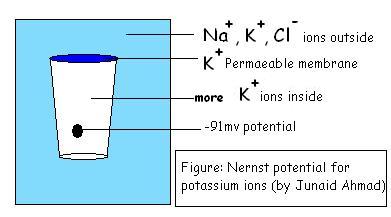 Common sense tells that positive potassium ions will be more attacted inside due to negative charge
Common sense tells that positive potassium ions will be more attacted inside due to negative charge
Against the concentration gradient potassium ions will be more inside than outside and water molecules will also enter the glass by osmosis.
Now we take another glass and tie a red membrane on its mouth which is only permeable to water and sodium ions only and not any other ion.
We put this glass inside the bucket (having potassium chloride and sodium ions) instead of previous glass.
After some time water and sodium ions will enter the glass and no any other ions will enter because memrane is not permeable to any other ion.
Now consider another thing that red membrane is not so much permeable for sodium ions as blue membrane was for potassium ions then we can conclude that sodium influx will be much less as compared with potassium influx without applying potential.
 But if we apply a +61 mv potential inside the glass then what will hapen.
But if we apply a +61 mv potential inside the glass then what will hapen.
Obviously positive sodium ions will move out of the glass due to positive potential inside and there would be less sodium ions inside as compared with outside.
Now we cosider that a membrane which is permeable to both of these ions which is the cell membrane of living cells during resting membrane potential i.e. the membrane which is not conducting nerve impulse.
For real living cells in resting membrane potential
- The cell membrane of nerve cell is premaeble to both sodium and potassium ions but 100 times more for potasium ions than sodium ions.
- There are large organic ions inside the cell which create negativity inside. To balance this negativity sodium and potassium ions enter into the cell but potassium enter 100 times more than sodium ions due to greater permeability.
- Morover those sodium ions which succeed to enter cell are pumped back to outside by the sodium potassium pump.
- Sodium-Potassium pumps are proteins embeded in cell membranes which work by use of ATP and in each turn pump 3 sodium outside and 2 potassium inside the membrane creating a potentail gradient (more positive outside) and concentraion gradients (more sodium outside and more potassium inside).
- In resting membrane positive sodium ions want to come inside to balance their concentration and also the negativity inside but they cannot come due to less permmeability of membrane for them and those who come are again pumped back by Sod-Potassium pump.
- In resting membrane positive potassium ions want to go inside due to negativity inside and also in same time want to go outside to balance concentraion gradient. So both effects are balanced at a certain concentration (more inside less outside).
is that if we cosider only one type of ions (and there would not be any other ions) then how much amount of potential is needed to keep those ions in same concentration as in real cell. And value of this potential is called nernst potential.
If we want to know how much is the Nernst potential for any one ion knowing its concentraion inside and outside the membrane, we can by help of Nersnt equation which is
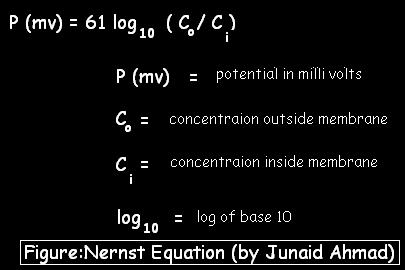
How this equation has beed derived?
We know that due to supposed Nernst potential ions move inside or outside membrane depending upon nature of ions and sign of Nernst potential.
But at a certain point the conc. of ions is balance between conc. gradient and potential gradient and at this point there is dynamic equillibrium between ions moving inside and outside membrane.
Derivation of this equation is based on thermodynamics. In a state when there is no net movement of ions across membrane then

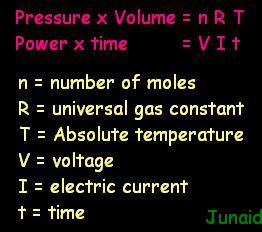
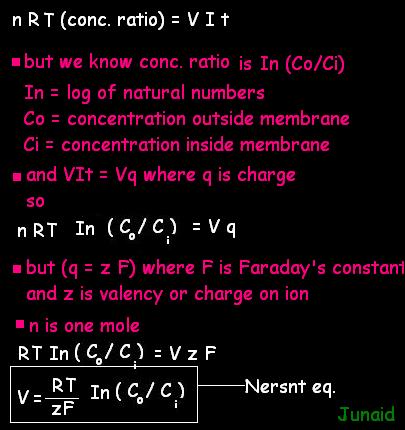
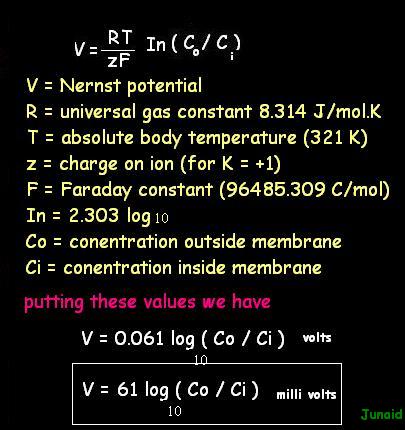
Final equation is for univalent ions at human body temperature at constant pressure
